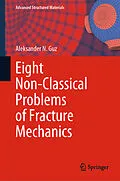This book presents an analysis of eight non-classical problems of fracture and failure mechanics mainly obtained by research in the department of dynamics and stability of continuum of the S. P. Timoshenko Institute of Mechanics of the National Academy of Sciences of Ukraine (NAS of Ukraine). It focusses on the application of the 3D (three-dimensional) theories of stability, dynamics, and statics of solid mechanics to the investigation of non-classical problems of fracture and failure mechanics.
Autorentext
A.N.Guz is Director of the S. P. Timoshenko Institute of Mechanics of the NASU, Ukraine. His principal scientific results have been obtained in mechanics of deformable solids and related problems of continuum mechanics: the three-dimensional theory of stability of deformable bodies, the theory of propagation and diffraction of elastic waves in multi-connected bodies and bodies with initial stresses, stress concentration around holes in shells, mechanics of composites materials and structural members utilizing them, aerohydroelasticity, non-classical problems of fracture mechanics, rock mechanics, dynamics of viscous compressible liquid, contact problems, and mechanics of nanocomposites and non-destructive methods of stress determination.
Inhalt
Foreword.............................................................................................................................................. 7
Introduction...................................................................................................................................... 11
Part I. General problems
Chapter 1. Division into classical and non-classical problemsof fracture mechanics........................................................................ 15
1.1 Classical problems of fracture mechanics.............................................................................. 15
1.2. Non-classical problems of fracture mechanics..................................................................... 16
1.3. Eight non-classical problems of fracture mechanics........................................................... 17
1.4. Additional discussion of non-classical problems of
fracture mechanics.................................................................................................................... 20
1.4.1. A brief discussion of models and approaches in non-classical
problems of fracture mechanics. Problems 1 to 8 (21). 1.4.2. On
consideration of non-classical problems of fracture mechanics in
terms of classic problems of fracture mechanics (24). 1.4.3. About
some other publications (26).
Chapter 2. Brief statement of foundations of three-dimensional linearized
theory of the deformable bodies stability (TLTDBS).............................. 27
2.1 On the formation of TLTDBS . 27
2.2. Classification of approaches (variants of theory) in TLTDBS . 31
2.2.1. Theory of large (fiinite) sub-critical deformations (31).
2.2.2. The first variant of the theory of small sub-critical deformations (33).
2.2.3. The second variant of the theory of small sub-critical deformations (34).
2.2.4. About linearized theory of stability for small deformations
and small averaged angles of rotation (35). 2.2.5. On theory of incremental
deformations (36). 2.2.6. Approximate approach to TLTDBS(37). 2.2.7.
Notes (39).
2.3. On criteria of stability in TLTDBS........................................................................................ 41
2.3.1. Elastic bodies (42). 2.3.2. Plastic Bodies (43) 2.3.3. Bodies with rheological
properties (46).
2.4. General problems of TLTDBS................................................................................................ 49
2.4.1. The general formulation of TLTDBS for different models of
deformed bodies (49). Sufficient conditions for applicability of Euler's method
(statical method) (51). 2.4.3. Sufficient conditions of stability (53).
2.5. On the variational principles of TLTDBS for elastic and plastic bodies......................... 54
2.5.1. Hu-Vashitsu variation principle in TLTDBS for incompressible bodies
under "dead" external load. Unified form for theories 1, 2, and 3 (55).
2.5.2. Variational principle of TLTDBS for compressible bodies under
"following" load. Results for theory 3 (57).
2.6. General solutions for TLTDBS in homogeneous sub-critical conditions........................ 59
2.6.1. General solutions for compressible bodies (60). 2.6.2. General
Solutions of TLTDBS for incompressible bodies (62). 2.6.3. Complex
potentials in the plane problems of TLTDBS. Preliminary discussion (64).
2.6.4. Main relations a...
